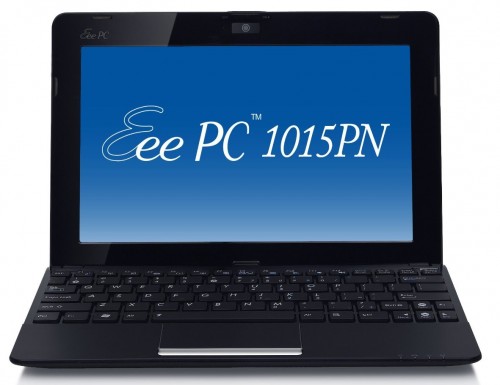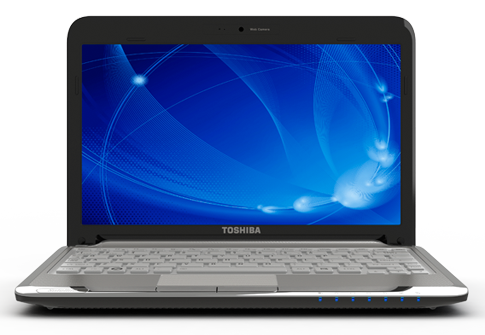Holiday Buyer's Guide: Notebooks
by Dustin Sklavos on November 15, 2010 9:00 PM EST- Posted in
- Laptops
- Guides
- Holiday 2010
Best Overall Netbook: ASUS Eee PC 1015PN-PU17 ($420)
While we don't have a whole lot of love here for Intel's Atom processor—it's dog slow and has seen virtually no evolution since its introduction—we do find there's a lot to like about its inclusion in the ASUS 1015PN.

The Eee PC 1015PN-PU17 is one of ASUS' myriad Atom-based offerings and part of their ever-growing Eee PC line, but it leverages every strength it conceivably can to produce what amounts to a sort of king of the netbooks: a dual-core Atom N550 processor coupled with NVIDIA's NG-ION graphics hardware. Naturally the netbook is Optimus-enabled, able to switch between the NG-ION and Atom's dire integrated graphics to improve battery life. The 1015PN also includes an increasingly rarefied matte screen, making it far more capable for the kind of outdoor use that netbooks should be ideal for.
If the Eee PC 1015PN has one Achilles' heel, it's battery life that comes up fairly short compared to the competition. The problem is that while it supports Optimus, you need to run the full Windows 7 Home Premium to get it... and ASUS ships the thing with Windows 7 Starter by default. Oops! So you lose dynamic GPU-switching (you can switch manually) but gain a much better netbook experience, at the cost of battery life. This is to be expected: there's a lot of extra power flowing through this system, but the payoff is in a machine that's more responsive and less aggravating to use than a basic single-core Atom netbook.
The rest of the 1015PN is bog standard for netbooks, with the usual 1GB of RAM and slow 5400-RPM hard drive. Bumping up to 2GB and Windows Home Premium will add another $100 or so to the total cost, and unfortunately ASUS continues to make it nigh impossible to actually upgrade the hard drive without tearing the system apart.
Netbook Runner Up: Toshiba T215D ($435)
If the idea of suffering through Atom in all of its glorious weaknesses doesn't sit right with you, Toshiba offers you another alternative: the AMD Nile-based T215D.

While Congo proved to be an exercise in "almost there," with Nile AMD finally proved they could bring the mayhem. The processors in this line are all derived from modern Athlon/Phenom II architecture, and they're consistently paired with the extremely capable Mobility Radeon HD 4225 integrated graphics.
What we're left with is a system that may not have the best battery life in the world (pushing just shy of five hours for typical use), but it's portable enough and gets along well enough in any other discipline. Even an NG-ION powered dual-core Atom is going to have trouble keeping up with a snappier Nile-based system, so if your usage pattern can't be squeezed into those narrow performance confines, the T215D is worth a look.
Technically some will complain that the T215D isn't a "netbook" since it uses an 11.6" chassis, but we're willing to stretch the definition. (Note that the higher spec Toshiba T235D we reviewed is larger still and sports a K325 dual-core processor in comparison to the K125 CPU in the T215D.) We wouldn't recommend any netbook as a powerful computing solution but rather as a "fast enough" alternative to Atom, and AMD's Nile offerings certainly fit that classification. The real question is whether you can live with the chromed-out silver aesthetics on the T215D.
When Portability Matters Most: ASUS 1015PED-MU17 ($326)
We've bashed on Atom performance plenty, but let's be clear: there's a niche that Atom fills perfectly well. That niche is the lightweight, inexpensive, long battery life netbook. Shop around and you can find cavalcade of similarly specced netbooks marching by, all tipping the scales at under 3lbs. and 8-10 hours of battery life, and priced to move starting at under $300. We'd recommend spending a bit more to get something with improved features and a larger battery life, though, which is why we return again to the ASUS Eee PC line. In fact, we ended up at the exact same 1015PN, this time without NG-ION. That means you keep the matte LCD but boost battery life up to 10 hours and save $100 in the process.
As an alternative to the ASUS 1015PN, you might also look at the Samsung N150-JP05 (JPxx). ASUS tends to get better battery life out of their netbooks in our testing, but the N150 also sports a matte LCD and has a different look that some will prefer over the ASUS clamshell design, and pricing starts at $300 instead of $325.










50 Comments
View All Comments
JarredWalton - Monday, November 15, 2010 - link
Fixed, thanks.StrangerGuy - Tuesday, November 16, 2010 - link
For those who are lucky enough to purchase one, 3820TG with 5650m is the undisputed king of ultraportables...Zero contest when talking about the ~$800 price range.satyr451 - Tuesday, November 16, 2010 - link
100% agree! I looked around at a pile of laptops and that system (Acer TimelineX 3820TG) is nothing short of amazing for the price. I just got it a few days ago and I'm all around impressed with it. It looks nice, has great battery life, feels solid and the specs on it are great. Also, I don't mind the keyboard at all.mschira - Tuesday, November 16, 2010 - link
There is one model missing from the list: the Sony Vaio z-series.The light gaming powerhouse!
Having a GT 330 and up to i7 CPUs, a high definition screen in a 1.4 kilo 13" package is simply amazing.
And it not more expensive than similarly speced MacBook Pro 15".
If you recommend the apples, you have to consider the Sony, too.
Worse I hear Anand complaining that all the notebooks are alike that there is no model standing out.
How does the z-series not stand out?
Cheers
M.
Evil_Sheep - Tuesday, November 16, 2010 - link
Anandtech didn't overlook the Z, but they noticed it stood out mostly in the wrong way: price. At $1700-2000 it even makes Apples look like a bargain.It's a nice machine but an overpriced niche product. If Sony dropped some of the bleeding-edge specs and released it at $1000-1200 they might not just be a bit-player in the notebook market.
mschira - Tuesday, November 16, 2010 - link
But claiming that the Sony Z-series is overpriced it simply wrong.Yes they start at a whooping 1800, but then they come with a 128Gb SSD and with fast i5-460, 4 Gb of ram.
Try it yourself, for 1800 you get a Macbook pro 13 with an SSD but a slower CPU.
Yes the Z-series is expesive, but that's because the ONLY come with SSD.
And a fast one!
Now I hear Anand tell us all the time we WANT SSDs in our laptops.
M.
mschira - Tuesday, November 16, 2010 - link
P.S. and whe you max them out the Sony Z series is 2800, but that's with a 8GB ram 256 SSD, i7-640 an Nvidia GT335 and a highdef screen.The mac 15' clocks in at a whooping 3500$ if you try to match this.
M.
JarredWalton - Tuesday, November 16, 2010 - link
Comparing with the MacBook isn't doing your argument any favors, as we've already established that they're fleecing the customer. Two 64GB SSDs will run about $220 at Newegg (and they'd actually be higher performance models than what Sony uses in all likelihood). Plus putting SSDs in RAID0 is stupid unless you're using models with excellent resiliency and garbage collection; I think Sony is using Samsung SSDs, which have neither feature.So start at a basic 13.3" laptop size. Acer gives you that in the 3820T for around $700. Now upgrade the keyboard to something decent with backlighting; that will cost around $50 tops. Put in Optimus 330M for around $100. Make a slick carbon fiber chassis for $100. Upgrade to dual SSDs for $150 (subtracting the standard HDD cost). Fingerprint reader and Bluetooth for $75. Upgrade the CPU to the i5-460M for $100. Toss in a good 900p LCD for $200 (being generous here). Add all of that up and we're looking at a base cost of around $1475, and I figure the above prices already account for the R&D department. So, your "Sony VAIO Z tax" looks to be around 22% -- just like Apple's MacBook tax I guess.
Is it an awesome laptop? By most accounts yes, though now I'd like to see the 420M in there instead of the 330M. But like the MacBook, you need to understand that you're paying significantly more for the "Sony experience". And honestly, dual HDD bays in a 13.1" chassis seems more like a case of proving you CAN do something as opposed to doing something people are clamoring for. I'd rather have a single 128GB SSD with good TRIM support than RAID0 64GB SSDs--or a single 256GB SSD with TRIM instead of RAID0 128GB SSDs. Or a bigger battery, or better cooling, or whatever. Again, not that the VAIO Z is bad, but it's almost an exercise in excess.
mschira - Wednesday, November 17, 2010 - link
Well if only there was 13" laptop with a Gt330. Or any other decent GPU for that matter. Of course I would not say no to an even better GPU (is the 420 better that the 330?).Or any real light 13" with a fast CPU for that matter - heck ANY notebook under 2k with a decent GPU - (maybe the alienware, but 11" is too small).
Nobody said the Sony Zs are cheap, but not more so than MacBook, and everybody seems to thinks it's kinda O.K. for them.
(Evil_Sheep even suggested the Sony prices make Mac look like a bargin - not so. Mac's are in fact more expensive, while weighting more).
Not sure what sort of SSD Sony is using, but I don't think they have really hard drive Bays in a 13" casing. They offer up to 4 SSDs in RAID and they sure don't have 4 bays.
In fact I would prefer a standard drive bay myself, so I can get a decent Sandforce SSD in case the factory build in models fail.
M.
narayanagame - Thursday, November 18, 2010 - link
what non sense are you talking...there is no competition for vaio z for its specs at that price..
i understand sony premium but vaio z is completely reasonable and i am being modest here.
whatever laptop u consider wont match vaio z with its specs for 3lb weight..
vaio z is marvelous.
look, u think 1800$ is premium price and in my country vaio z starts at 2200$ and i still feel its good enough.
in real there is no laptop that has as good specs as vaio z at its weight for that price.compare it with whatever you like nothing ll match atleast till CES 2011
now dont compare with macbook's,they are underpowered with shiny looking casing.
the main thing that goes for apple is good screen and battery life and aesthetics and for these they charge easily 40% extra.
if you think properly battery ability ll wear off within 1 and half yr and you wont be able to replace yourself.